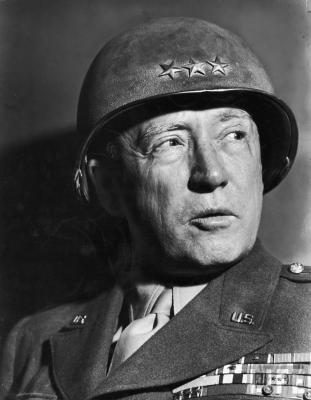Trump’s military hero responsible for Sicily war crimes

ROME -- When President Donald Trump named General James “Mad Dog” Mattis as secretary of defence he described the former marine as “the closest thing we have to Gen. George Patton.” At about the same time the last witness to war crimes commited in Sicily under Patton’s command was dying at the age of 99 in his native Palermo.
Giuseppe Giannola was an Italian Air Force driver who miraculously survived a triple execution at the hands of American troops after participating in the spirited defence of Biscari air field, as Allied soldiers poured onto the west coast of the island as part of Operation Husky.
Giannola was one of around 50 Italian and German soldiers who surrendered to US troops of the 180th Infantry Regiment on July 14, 1943. Having been stripped of their shoes, shirts and trousers to discourage attempts at escape, the majority of the men were drawn up in three lines and mown down with machinegun fire.
Giannola was hit in the wrist and buried under the bodies of his dying comrades. “I could see nothing. I could only hear the explosions that seemd to have no end. First long bursts, then single shots, becoming less frequent. Those were the coups de grace,” Giannola told the Corriere della Sera in a 2005 interview.
Thinking that the Americans had left, he got to his feet only to be shot for a second time, with the bullet lightly grazing his head. The Italian serviceman was later shot for a third time, the bullet passing through his lung and narrowly missing his heart, after he sought help from more American troops in a passing jeep. He was eventually picked up and treated at a British military hospital in North Africa.
Giannola recounted his experience to Allied military authorities while still a prisoner and again to the Italians, who had initially accused him of desertion, in 1947. Even his own children found it difficult to believe his story.
In September 1943 a US non-commissioned officer, Sergeant Horace T. West, was court-martialled for the massacre of 37 prisoners of war, which he carried out single-handed, after telling comrades to “turn around if you don’t want to see it.” Giannola was one of his victims.
At his trial West argued that he was suffering from “temporary insanity”, had been infuriated as a result of witnessing atrocities committed by the enemy, and was following Gen. Patton’s orders that prisoners should only be taken under limited circumstances. He was sentenced to life imprisonment, which was later commuted.
Another soldier, Captain John T. Compton, was acquitted of ordering the execution of 36 prisoners of war in the same area and on the same day, after he too claimed he was following Gen. Patton’s instructions.
Patton dismissed the matter as “probably and exaggeration” when first told of the atrocities. He instructed Gen. Omar Bradley, who was under his command, to “tell the officer responsible for the shootings to certify that the dead men were snipers or had attempted to escape or something, as it would make a stink in the press.” Bradley refused.
At his trial Captain Compton cited a speech by Patton to officers of the 45th Infantry Division, delivered in North Africa in preparation for Operation Husky. The officers were urged to “show no mercy” and not to accept the surrender of enemies who had continued fighting at close quarters. “When word reaches him that he is being faced by a killer battalion, a killer outfit, he will fight less,” Compton claimed the maverick general had said of the enemy. Another officer testified that Patton had said “the more prisoners we took, the more we’d have to feed, and not to fool with prisoners.”
The records of both trials were kept secret until the late 1950s, initially because they might have caused enemy reprisals and later for fear of an outcry in the press.
Patton himself told investigators that his remarks had been misinterpreted and he was ultimately cleared of wrongdoing. Some historians have argued, however, that had the principles applied to SS officers convicted of atrocities been applied to the Biscari massacres then Patton would have been sentenced to life imprisonment.
Andrea Augello, a rightwing politician and author of a book about the massacres, believes the story was long suppressed in Italy as well, because it ran contrary to the dominant post-war narrative: the Italians in Sicily had fought bravely against their “liberators” and the war crimes had been committed by the victors, who got to write the history books.
In his book, “Kill the Italians,” Augello wrote: “On the whole the battle for Gela was fought with ferocious determination by the American soldiers, who, in various circumstances, showed little regard for the civilian population, for prisoners, and for the Geneva Convention.”
Giannola’s sacrifice was finally recognised by the Italian state during the last decade of his life, but investigations by Italian military prosecutors were unable to make further headway on the wider responsibilities for the Biscari massacres.
Mr Trump’s choice of Patton as a model for the modern US military is probably as ill-advised as his contention that “torture works.” The hard-driving tank commander may have got results on the battlefield, but as the Biscari episodes show, he was not the best example of the values for which the Allies fought.
pw


